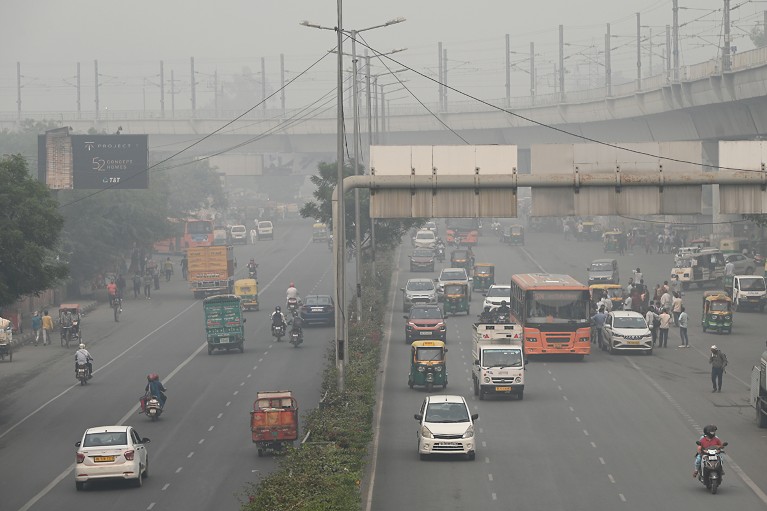
Air pollution ranges in Delhi have hit hazardous ranges, prompting the Indian authorities to attempt cloud seeding as a radical method to tackling the issue.Credit score: Prakash Singh/Bloomberg by way of Getty
An bold try by the Indian authorities to fight Delhi’s hazardous air air pollution by inducing synthetic rain has did not set off any precipitation, prompting researchers to query why the experiment went forward.
The experiment was carried out in collaboration with the Indian Institute of Know-how (IIT) Kanpur on 28 October. Two plane flew over a number of areas of Delhi and launched flares containing particles of silver iodide and sodium chloride into the environment, with the objective of catalysing condensation and producing rain.
The Delhi authorities and IIT Kanpur say that the seeding experiment led to a slight lower in air pollution, however scientists assume the development had little to do with the intervention.
“It looks as if the skies have cleared, however it’s as a result of the climate situations have modified. That’s no credit score to the seeding efforts,” says Shahzad Gani, an aerosol scientist at IIT Delhi.
Poisonous smog
Each winter for nearly a decade, Delhi and surrounding areas have battled hazardous ranges of high quality particulate matter within the air, produced by trade, car emissions and the burning of crop stubble in neighbouring states. On some days, air pollution ranges are as much as 20 occasions larger than the World Well being Group’s beneficial limits.
In October and November, the air in and round Delhi turns into cooler, drier and extra secure, which slows the dispersal of pollution. The Delhi authorities has tried taking numerous measures to enhance air high quality, reminiscent of shutting down polluting industries and banning firecrackers throughout Diwali festivities. However poor compliance has meant that almost all of those initiatives have had little impact. This 12 months, when air pollution ranges grew to become hazardous the evening after Diwali celebrations, the federal government determined to take a distinct method.
The strategy of cloud seeding — firing small particles reminiscent of silver iodide and sodium chloride into current clouds to assist water vapour to condense — has been round for the reason that mid-twentieth century. However dependable proof that the method can induce rainfall on demand is missing, and its capacity to disperse air pollution has not been examined, says Gani.
Roxy Mathew Koll, a local weather scientist on the Indian Institute of Tropical Meteorology, Pune, says the atmospheric situations weren’t appropriate for the experiment to succeed. “Cloud seeding can solely improve rainfall if there are already moist, convective clouds with adequate liquid water. In dry or stagnant air, there’s merely nothing to seed,” Koll says. On the time of the experiment, “two storms — a despair within the Arabian Sea and a cyclone within the Bay of Bengal — had been pulling the moisture into these areas and making Delhi drier”.
One other trial scheduled for Wednesday was cancelled. Manindra Agrawal, director of IIT Kanpur, informed Indian information company ANI that the experiment will likely be postponed till a day when the moisture content material of clouds is at the very least 40–50%.
Earlier this 12 months, the Royal Rainmaking Undertaking in Thailand tried to fight air pollution by spraying chilly water from planes, hoping that this is able to permit among the particulate matter trapped in a layer of heat air within the environment to dissipate.